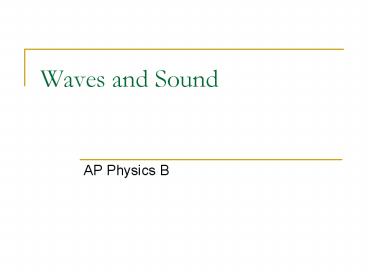Waves and Sound PowerPoint PPT Presentation
1 / 17
Title: Waves and Sound
1
Waves and Sound
- AP Physics B
2
What is a wave
- A WAVE is a vibration or disturbance in space.
A MEDIUM is the substance that all SOUND WAVES
travel through and need to have in order to move.
3
Two types of Waves
- The first type of wave is called Longitudinal.
Longitudinal Wave - A fixed point will move
parallel with the wave motion
2 areas Compression- an area of high molecular
density and pressure Rarefaction - an area of low
molecular density and pressure
4
Two types of Waves
The second type of wave is called Transverse.
Transverse Wave - A fixed point will move
perpendicular with the wave motion.
Wave parts(recall demo for simple harmonic motion
)- crest, trough, wavelength, amplitude,
frequency, period
5
Wave Speed
You can find the speed of a wave by multiplying
the waves wavelength in meters by the frequency
(cycles per second). Since a cycle is not a
standard unit this gives you meters/second.
6
Example
- A harmonic wave is traveling along a rope. It is
observed that the oscillator that generates the
wave completes 40.0 vibrations in 30.0 s. Also, a
given maximum travels 425 cm along a rope in 10.0
s . What is the wavelength?
0.0319 m/s
7
Standing Waves
- A standing wave is produced when a wave that is
traveling is reflected back upon itself. There
are two main parts to a standing wave - Antinodes Areas of MAXIMUM AMPLITUDE
- Nodes Areas of ZERO AMPLITUDE.
8
Sound Waves
- Sound Waves are a common type of standing wave as
they are caused by RESONANCE. - Resonance when a FORCED vibration matches an
objects natural frequency thus producing
vibration, sound, or even damage.
One example of this involves shattering a wine
glass by hitting a musical note that is on the
same frequency as the natural frequency of the
glass. (Natural frequency depends on the size,
shape, and composition of the object in
question.) Because the frequencies resonate, or
are in sync with one another, maximum energy
transfer is possible.
9
Sound Waves
- The production of sound involves setting up a
wave in air. To set up a CONTINUOUS sound you
will need to set a standing wave pattern. - Three LARGE CLASSES of instruments
- Stringed - standing wave is set up in a tightly
stretched string - Percussion - standing wave is produced by the
vibration of solid objects - Wind - standing wave is set up in a column of air
that is either OPEN or CLOSED - Factors that influence the speed of sound are
density of solids or liquid, and TEMPERATURE
10
Closed Pipes
- Have an antinode at one end and a node at the
other. Each sound you hear will occur when an
antinode appears at the top of the pipe. What is
the SMALLEST length of pipe you can have to hear
a sound?
You get your first sound or encounter your first
antinode when the length of the actual pipe is
equal to a quarter of a wavelength.
This FIRST SOUND is called the FUNDAMENTAL
FREQUENCY or the FIRST HARMONIC.
11
Closed Pipes - Harmonics
- Harmonics are MULTIPLES of the fundamental
frequency.
In a closed pipe, you have a NODE at the 2nd
harmonic position, therefore NO SOUND is produced
12
Closed Pipes - Harmonics
- In a closed pipe you have an ANTINODE at the 3rd
harmonic position, therefore SOUND is produced. - CONCLUSION Sounds in CLOSED pipes are produced
ONLY at ODD HARMONICS!
13
Open Pipes
- OPEN PIPES- have an antinode on BOTH ends of the
tube. What is the SMALLEST length of pipe you can
have to hear a sound?
You will get your FIRST sound when the length of
the pipe equals one-half of a wavelength.
14
Open Pipes - Harmonics
- Since harmonics are MULTIPLES of the fundamental,
the second harmonic of an open pipe will be ONE
WAVELENGTH.
The picture above is the SECOND harmonic or the
FIRST OVERTONE.
15
Open pipes - Harmonics
- Another half of a wavelength would ALSO produce
an antinode on BOTH ends. In fact, no matter how
many halves you add you will always have an
antinode on the ends
The picture above is the THIRD harmonic or the
SECOND OVERTONE. CONCLUSION Sounds in OPEN
pipes are produced at ALL HARMONICS!
16
Example
- The speed of sound waves in air is found to be
340 m/s. Determine the fundamental frequency (1st
harmonic) of an open-end air column which has a
length of 67.5 cm.
251.85 HZ
17
Example
- The windpipe of a typical whooping crane is about
1.525-m long. What is the lowest resonant
frequency of this pipe assuming it is a pipe
closed at one end? Assume a temperature of 37C.
353.2 m/s
57.90 Hz

